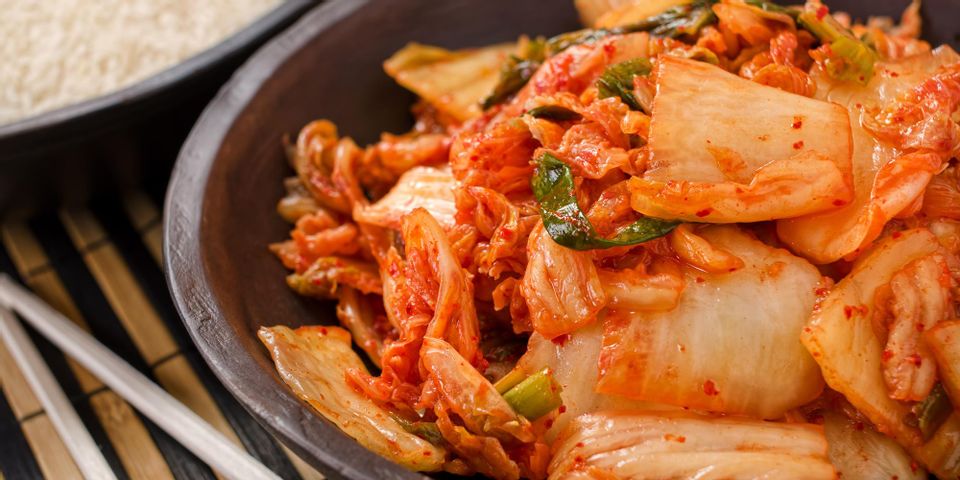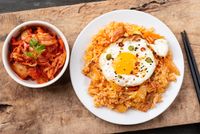
Kimchi is a delicious type of Korean food made with cabbage, spices, and other herbs and vegetables. Like other fermented foods, such as yogurt and sauerkraut, it is full of beneficial bacteria and probiotics and is excellent for digestive health. Read the guide below to discover more about this beloved Korean dish.
All About Kimchi
Origins of Kimchi
 The practice of fermenting food in Korea came about because of the need to preserve vegetables through the long winters. Packing vegetables with salt or in brine helped keep produce edible, and the salt aided in the digestion of grains. Early kimchi dates from the Three Kingdoms period in Korean history, 57 B.C.E. – 668 C.E. The first kimchis were not made with the cabbage that is widely used today, but rather radishes. More vegetables came into Korea over time, including hot peppers during the Joseon Dynasty (1392-1910), which changed the look of the dish and its preparation. During this time many types of vegetables and meats were added to kimchi, the most notable and popular being Tongbaechu kimchi—the one most people have tried as an accompaniment to other Korean foods.
The practice of fermenting food in Korea came about because of the need to preserve vegetables through the long winters. Packing vegetables with salt or in brine helped keep produce edible, and the salt aided in the digestion of grains. Early kimchi dates from the Three Kingdoms period in Korean history, 57 B.C.E. – 668 C.E. The first kimchis were not made with the cabbage that is widely used today, but rather radishes. More vegetables came into Korea over time, including hot peppers during the Joseon Dynasty (1392-1910), which changed the look of the dish and its preparation. During this time many types of vegetables and meats were added to kimchi, the most notable and popular being Tongbaechu kimchi—the one most people have tried as an accompaniment to other Korean foods.
How Kimchi Is Made
The basic recipe for Tongbaechu kimchi includes Napa cabbage, salt, sugar, onion, garlic, ginger, and gochugaru—a distinctive Korean red pepper powder. Authentic Korean recipes may contain a host of other ingredients, from pears and apples to radishes and salted shrimp. The vegetables are chopped and brined for a few hours with water and salt, then drained and combined with the kimchi paste, made from the other blended ingredients. The kimchi is stored in a covered container and allowed to ferment a day or so at room temperature and then in the fridge. The longer it ferments, the stronger it is—creating a unique taste that pairs with all kinds of Korean food.
Different Types of Kimchi
There are hundreds of types of kimchi, but some of the most popular are:
-
Oi Sobagi Kimchi: made with cucumber and a spicy kimchi paste, this type is fresh and crunchy but not fermented.
-
KKakdugi Kimchi: traditional kimchi paste that is best paired with radishes rather than cabbage.
-
Yeolmu Kimchi: also made with radish, but using young vegetables with leafy tops.
-
Nabak Kimchi: known as “water kimchi,” this watery, fermented blend of cabbage and radish goes well with noodles and soups.
Kimchi is eaten with any savory food. Try it in kimchi stew, with stone pot rice, tofu stew, fried rice, any noodle dish, or soup. Or, enjoy it straight out of the jar!
Korean food is spicy and full of unique flavors and ingredients. New Shilawon Korean Restaurant 뉴신라원, in Honolulu, HI, serves up affordable, traditional, and delicious Korean food for lunch and dinner. Established in 1994, they are one of the oldest South Korean restaurants in the U.S. and are Honolulu’s premier Yakiniku dining spot. Call (808) 944-8700 for reservations, find them on Facebook, Yelp, or Instagram, or visit the website to view the menu.
About the Business
Have a question? Ask the experts!
Send your question

